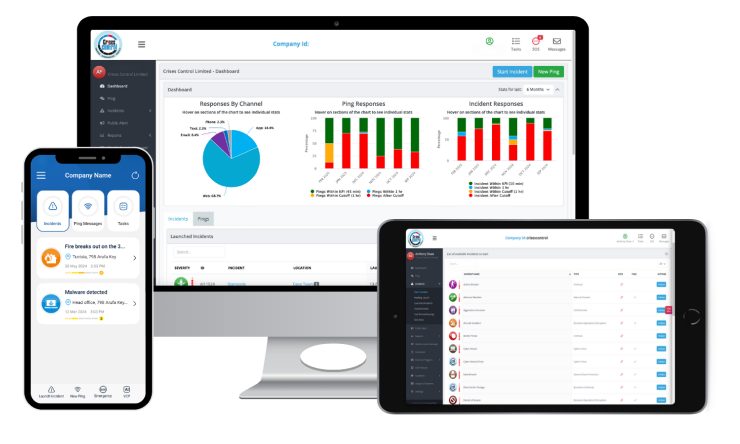Written by Anneri Fourie | Crises Control Executive
The Problem: Profitability Alone No Longer Builds Trust
Investment firms have always been judged by performance, stability, and governance. But in recent years, something has changed. Investors and regulators are now asking a different question: Can your firm keep operating when something goes wrong?
The financial sector depends on confidence. A system outage, cyber incident, or supplier failure can quickly disrupt trading, unsettle clients, and damage a firm’s reputation. Profit alone is no longer a guarantee of trust. What investors want to see today is preparedness.
This shift has made operational resilience one of the most important measures of credibility for investment firms. The firms that plan for disruption, respond with coordination, and recover quickly are now seen as safer and more dependable partners.
Crises Control provides the technology foundation that helps firms achieve that preparedness, turning resilience into a measurable and visible strength.
Understanding Operational Resilience in Investment Firms
Operational resilience means being able to keep critical parts of your business running, no matter what disruption you face. For investment firms, that includes trading, settlements, and client communications. The goal is not just to recover after an incident, but to continue delivering essential services during it.
This concept goes beyond traditional business continuity planning. The Financial Conduct Authority (FCA) and the Prudential Regulation Authority (PRA) now expect firms to show that they can manage through disruption, not just bounce back afterwards. Their frameworks require firms to:
- Identify important business services.
- Set impact tolerances, which define how much disruption the business can handle before clients or markets are affected.
- Test response plans and make improvements.
This has turned operational resilience into a continuous discipline rather than a box-ticking exercise.
Why Operational Resilience Is Now Part of Due Diligence
In the past, due diligence in finance was focused on profitability, compliance, and risk exposure. Those elements still matter, but investors now view resilience as part of the same equation. A strong balance sheet is no use if your firm cannot operate during a crisis.
Institutional investors, regulators, and partners want assurance that your organisation can manage disruption effectively. They want to know:
- How quickly can you restore trading if your systems go down?
- How do you communicate with investors and clients during an incident?
- How do you manage dependencies on third-party technology and service providers?
Firms that can answer these questions confidently show that they are in control. This inspires trust and proves that they are not only managing risk, but actively building resilience into their operations.
The FCA’s policy on operational resilience (PS21/3) makes these expectations clear. Investment firms must identify their most important business services and state how much disruption they can tolerate before clients are affected. Resilience is no longer optional; it is an expectation that sits at the heart of regulatory and investor scrutiny.
The Real Cost of Inadequate Resilience
When operational resilience fails, the impact goes far beyond downtime. Disruption in an investment firm can cause confusion, client losses, and even financial penalties. A single communication failure during a cyber incident can cause panic among investors. A delay in processing transactions can create compliance breaches and reputational harm.
Common weak points include:
- Teams working in isolation without shared information.
- Poor or delayed communication during incidents.
- Business continuity plans that are not updated or tested.
- A lack of evidence for regulators to show preparedness.
These issues can make a firm appear disorganised and reactive, both to investors and regulators. They also create financial risk, as unplanned downtime and poor crisis management often lead to missed opportunities and regulatory fines.
How Investment Firms Can Demonstrate Operational Resilience to Regulators
Regulators want evidence that operational resilience is more than just a policy document. They expect firms to show that their plans, processes, and tools work in practice. The following steps can help build that evidence:
1. Map Critical Business Services
Identify which services are essential to your firm’s success and customer commitments. Then, list every dependency that supports those services; technology systems, third-party providers, and key staff.
2. Define Impact Tolerances
Decide how long each essential service can be disrupted before clients, investors, or regulators are affected. These tolerances create clear performance targets for resilience.
3. Test and Simulate Scenarios
Run regular exercises that simulate realistic disruptions, such as data breaches, power failures, or loss of connectivity. Testing exposes weaknesses early, allowing you to improve your response before a real incident occurs.
4. Record and Review
Document every incident and drill, noting what worked well and what did not. This creates the audit trail regulators expect to see.
5. Strengthen Communication Channels
Establish clear communication systems that reach the right people at the right time. This ensures everyone, from staff to regulators, receives accurate and timely updates.
These activities not only meet regulatory expectations but also improve internal efficiency and confidence across the business.
The Role of Crises Control in Building Operational Resilience
Achieving resilience requires visibility, coordination, and communication. This is where Crises Control helps investment firms transform preparation into practice. Our crisis management software brings together all the elements of resilience, from communication and control to testing and reporting, into one secure platform.
1. Centralised Command and Control
During a crisis, clear decision-making is essential. Crises Control provides a single dashboard where incident managers can track developments, assign tasks, and monitor progress in real time. This prevents teams from working in isolation and ensures that all actions align with the firm’s resilience objectives.
The system also creates a complete record of every decision, making it easier to demonstrate accountability to regulators after an incident.
2. Intelligent Mass Notification
Clear communication prevents confusion. Crises Control’s mass notification system allows firms to send targeted alerts through multiple channels, including SMS, voice calls, email, and push notifications through the Crises Control app and Microsoft Teams.
Messages can be pre-set and triggered automatically based on the type of incident. This ensures that staff, clients, and partners receive consistent information, even if core systems are down. In a regulated environment, timely and accurate communication protects both reputation and compliance.
3. Real-Time Reporting and Audit Trails
Transparency builds trust with regulators and investors. Crises Control automatically records every action during an incident, creating a detailed audit trail.
Reports can be generated instantly to show how the firm responded, how long recovery took, and what improvements were made afterwards. This turns crisis data into measurable evidence of resilience.
4. Scenario Testing and Simulation
Operational resilience cannot be proven without testing. Crises Control allows firms to run realistic simulations that mirror possible threats, from cyber incidents to supplier outages.
These exercises help identify weak points in plans and processes. They also ensure that staff understand their responsibilities during disruption, improving confidence and coordination.
5. Cloud-Based Continuity
When systems fail, access to communication tools should not depend on local servers. Crises Control’s cloud-based design keeps incident management and communication tools available even during internal IT outages.
This ensures that senior leaders and crisis teams can make informed decisions without interruption, supporting business continuity across different locations and time zones.
Turning Compliance into Competitive Strength
Operational resilience is often viewed as a compliance requirement, but it can also be a source of competitive advantage. Resilient firms are more attractive to investors because they demonstrate preparedness, transparency, and reliability.
By showing that your firm can manage through disruption, you strengthen trust, protect your reputation, and maintain long-term client relationships.
A well-managed resilience strategy can:
- Safeguard client confidence during periods of uncertainty.
- Reduce financial losses linked to downtime or errors.
- Improve collaboration between departments and partners.
- Streamline regulatory reporting through better data management.
Crises Control supports this by giving firms a practical framework for testing, communication, and recovery. It helps turn resilience from a compliance obligation into a competitive strength that adds value to both the business and its clients.
Building a Culture of Resilience
Technology plays an important role in resilience, but culture is what sustains it. Operational resilience only works when every part of the organisation understands its role and responsibility.
Leaders set the tone by prioritising readiness, investing in training, and regularly reviewing plans. Teams contribute by engaging in drills, maintaining awareness, and sharing lessons learned from past incidents.
Crises Control helps firms embed this culture by making resilience planning accessible and easy to manage. Our intuitive tools encourage collaboration, making it simpler to keep plans up to date and ensure that everyone knows how to respond when disruption occurs.
Ready to Strengthen Your Firm’s Operational Resilience?
Operational resilience is no longer a background process. It defines how your firm is perceived by investors, clients, and regulators. The ability to continue operating during disruption has become a measure of professionalism and trust.
Crises Control helps investment firms manage crises, automate communication, and generate the evidence needed to prove compliance. It supports teams in responding quickly and maintaining control when it matters most.
Contact us today to request a free demo and see how Crises Control can help your firm demonstrate operational resilience with confidence.
Request a FREE Demo

